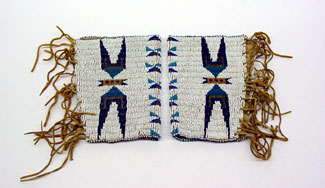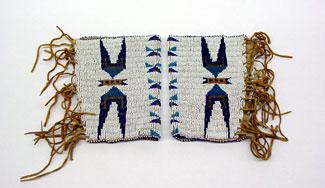Although the Plains Indians are often linked to their beadwork, the glass beads they used were actually of European origin and did not become popular until the mid-nineteenth century. Early plains beadwork was done on animal skin with simple designs using large irregularly shaped beads and just a few basic colors. Materials were not yet plentiful enough for loom work and they were usually used in conjunction with quillwork to add minor decoration to clothing. A few basic design forms were used, mostly geometric elements such as rectangles, triangles and bars. Plains Indians also used crosses, not as Christian symbols but rather as representing the cardinal directions, in early pieces. Early designs for beadwork mimicked those previously used in quillwork and other media. Beads became smaller and more delicate by the 1840s allowing for more detailed designs. Most designs remained geometric though, with circles, solid triangles, and K-shapes. Gradually, more and more objects were beaded but the work remained in just narrow bands because looms were not common yet. Designs remained consistent for most of the 1800s and individual tribes could be identified based on the color and design preferences of their beadwork.
The last part of the nineteenth century saw incredible growth in Plains art. The fur trade enabled Indians to acquire a wealth of material goods, including a surplus of colorful glass beads. Beadwork became the primary decorating method as it outpaced quillwork, the previous favorite. Economic conditions in the late 1800s further encouraged the mass manufacture of objects for sale to dealers, tourists, and collectors. After the Civil War, settlers arrived from the East bringing new influences and materials that were quickly incorporated into the native designs. Although the appearance of the beadwork changed dramatically as it grew more intricate and varied, the initial simple design units were still kept and reused. Regional styles developed so that differences in tribal decoration became even more distinct than before. By this point, loom weaving was flourishing as it allowed for a more consistent product than directly attaching the beads to a backing of leather or cloth. One of the more popular forms of loom work was aptly named the basic technique, a square weave which was simple to do and could be easily elaborated on for more intricate pieces.

Plains Bead Work Gauntlets
Gauntlets, Plains people, North America

Bag - Bead work
Bag, Plains people, North America
References:
Penney, David. Art of the American Indian Frontier. University of Washington Press. Seattle. 1992.
Goodhue, Horace R. Indian Bead-Weaving Patterns. Bead Craft. St. Paul. 1989.
Orchard, William C. Beads and Beadwork of the American Indians. Museum of the American Indian Heye Foundation. New York. 1975.
Text prepared by Chelsea Bilyeu
Photos by Chelsea Bilyeu
January 2007
